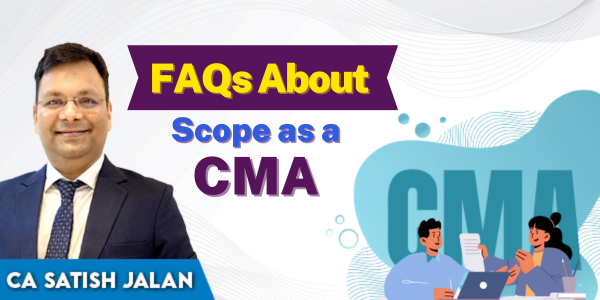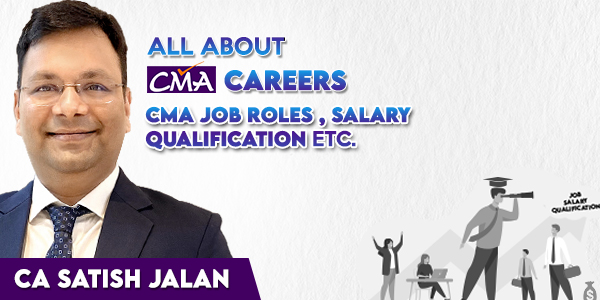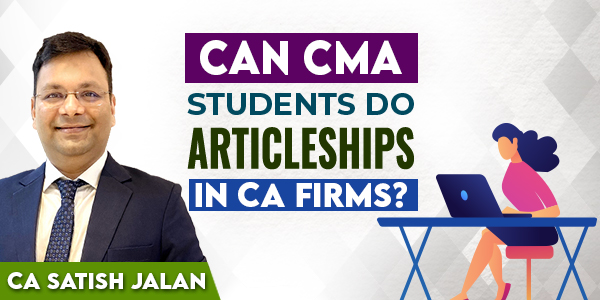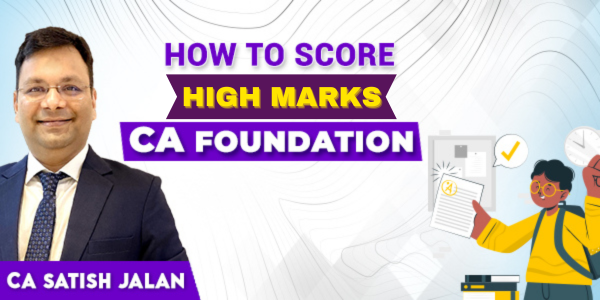22
May, 2023
FAQs about Scope as a CMA
-
CA Satish Jalan
The Cost and Management Accountants degree by The Institute of Cost Accountants of India is gradually gaining popularity in the professional courses field. Many students are aspiring for this course. Here, we will discuss the overview and scope of this course in an interesting question-and-answer format.
What does CMA stand for?
CMA stands for Cost and Management Accountant. It was formerly known as CWA (Cost and Works Accountant). In short, more popularly it is called a Cost Accountant.
Is it a degree or a diploma?
It is a degree course from the ICAI (Institute of Cost Accountants of India).
Any accolade from an Institute registered under the Government of India is recognised as a degree.
ICAI is a statutory body enacted under the jurisdiction of the Ministry of Corporate Affairs, Government of India.
Is CMA a full-time or a part-time course?
You may pursue CMA while working, as a part-time course. There are no attendance requirements in this course.
You have to just attend some orientation programs conducted by the Institute, for its students at different stages.
The beauty of this program is that even if you are working somewhere, the institute will accept the work experience based on the criteria defined by them. So, you need not do the practical training again.
For example: In case, if it's a manufacturing company, the turnover must be at least Rs.2 crores. In the same way, service industries must have revenue of Rs.50 lakhs to qualify.
Please note that if you are working or training in a CA firm, you won't get any exemption from the practical training.
How Many Levels Are There In CMA Course?
There are three levels in this course which are the Foundation level, Intermediate and Final level.
What are the eligibility criteria for the CMA Course?
You can join this course from the Foundation Route or the Direct Entry Route. Direct Entry students are exempted from the Foundation level.
Foundation Route
For the Foundation Route, you must have passed Class 12 from any stream.
Direct Entry Route
To be eligible for the Direct Entry Route, you must have completed your graduation, in any stream, through a recognized university.
There is no minimum mark required for the Direct Entry Route. On the contrary, to get admission in the CA course, you require a minimum of 55 per cent in graduation.
A CS student who has passed the Foundation level or a CA student who has passed the Intermediate level is also eligible for Direct Entry into the CMA Programme.
This course consists of a total of 20 subjects or papers. There are four papers at the Foundation level, eight at the Intermediate level, and eight at the Final level.
The Foundation Route students need to attempt all 20 papers. For the Direct Entry Route students, the total number of papers will be 16 papers.
Is the CMA course only for finance/commerce students?
You can pursue the CMA examination regardless of your stream.
But, before starting the CMA course, students from other streams should obtain a basic knowledge of subjects that are covered in the CMA course. You may join our free basic course by clicking here.
This course is definitely designed for the finance stream. Nowadays, any organisation requires financial decision-makers and controllers, who are involved in performance appraisal, cost management, and evaluating/ preparing quotations.
Besides, they also drive efficiency, and contribute to management reporting, MIS, and risk assessment.
What are the subjects in the CMA course?
Twenty subjects cover each and every aspect that a finance professional is expected to know. Let us take a brief look at them:
A. The Foundation level consists of four papers:
1. Old Syllabus:
- Fundamentals of Economics and Management. (Paper One)
- Fundamentals of Accounting. (Paper Two)
- Fundamentals of Law and Ethics. (Paper Three)
- Fundamentals of Business, Mathematics, and Statistics. (Paper Four)
2. New Syllabus
- Paper 1: Fundamentals Of Business Laws And Business Communication
- Paper 2: Fundamentals Of Financial And Cost Accounting
- Paper 3: Fundamentals Of Business Mathematics And Statistics
- Paper 4: Fundamentals Of Business Economics And Management
B. The Intermediate Level Consists Of eight papers:
2. Old Syllabus
CMA Intermediate Group One:
- Financial Accounting. (Paper Five)
- Law and Ethics. (Paper Six)
- Direct Taxation. (Paper Seven)
- Cost Accounting. (Paper Eight)
CMA Intermediate Group Two:
- Operation Management and Strategic Management. (Paper Nine)
- Cost and Management Accounting and Financial Management. (Paper Ten)
- Indirect taxation. (Paper Eleven)
- Accounts and Audit. (Paper Twelve)
2. New Syllabus: 2022
CMA Intermediate Group One:
- Paper 5: Business Laws And Ethics (Ble)
- Paper 6: Financial Accounting (Fa)
- Paper 7: Direct And Indirect Taxation (Ditx)
- Paper 8: Cost Accounting (Ca)
CMA Intermediate Group Two:
- Paper 9: Operations Management And Strategic Management
- Paper 10: Corporate Accounting And Auditing
- Paper 11: Financial Management And Business Data Analytics
- Paper 12: Management Accounting
C. The Final Level consists of two groups with four papers each.
1. Old Syllabus
CMA Final Group Three:
- Corporate law and compliance. (Paper Thirteen)
- Strategic Financial Management. (Paper Fourteen)
- Strategic Cost Management and Decision Making. (Paper Fifteen)
- Direct Tax Laws and International Taxation. (Paper Sixteen)
CMA Final Group Four:
- Corporate Financial Reporting. (Paper Seventeen)
- Indirect Tax Laws and Practice. (Paper Eighteen)
- Cost and Management Audit. (Paper Nineteen)
- Strategic Performance Management and Business Valuation. (Paper Twenty)
2. New Syllabus 2022
CMA Final Group Three:
- Paper 13: Corporate And Economic Laws
- Paper 14: Strategic Financial Management
- Paper 15: Direct Tax Laws And International Taxation
- Paper 16: Strategic Cost Management
CMA Final Group Four:
- Paper 17: Cost And Management Audit
- Paper 18: Corporate Financial Reporting
- Paper 19: Indirect Tax Laws And Practice
Electives
- Paper 20a: Strategic Performance Management And Business Valuation (Spmbv)
- Paper 20b: Risk Management In Banking And Insurance (Rmbi)
- Paper 20c: Entrepreneurship And Startup (Ents)
What is the investment/cost of the CMA Course?
- It is one of the most inexpensive courses. You can obtain the ROI on the money invested in this course right from your first/ second salary. The total cost of doing this course is Rs.65,000 approx, over a span of 3 to 4 years (excluding the coaching fees).
- Let us break it down, The Foundation Course costs Rs.6,000, the Intermediate Course Rs.23,000, and the Final Course Rs.25,000. There are nominal fees for the examination form, at each of the levels.
- Let us assume that the exam fees cost a total of Rs.10,000 for all the groups, which adds up to Rs.65,000 in total.
- You may also opt for Self Study. There are ample resources available online. You can go for subject-wise coaching also. The level of difficulty you have with the subjects will determine your investment in the coaching institute.
- Once you are qualified as a CMA, there are various opportunities available to you. You may choose to do a job or start your own firm/business.
- When it comes to the job, you will get opportunities in PSUs as a decision-maker. Several large manufacturing firms also hire Cost Accountants, who can handle all aspects of finance.
- CMA professionals are also hired by banks and NBFCs for their ability to understand risk management. Even IT companies are now hiring CMA professionals.
- As per the claims made by the Institute, the average salary for any CMA professional is Rs.8 lakhs a year. The public sector employers and non-public sector employers offer similar packages. However, the top package is around Rs.20 lakhs per year.
- You may open your own sole-proprietorship firm/ partnership firm. You may then hire CMA interns to work with you in your firm. You may apply to join the Institute's panel to work on a variety of projects. As per your capability, you may take up tax consultation and filing work as well.
- A CMA in practice can also be a Cost Auditor, a Cost Statements expert, a Management consultant, or an MIS expert.
- self-reliance is the ultimate goal of this course. Once you become a CMA, you become independent. Many students are living their dream lives after completing this course.
Please comment below, if you have any doubts or queries related to this course.
All About CMA Careers: CMA Job Roles, Salary, Qualification, et
Popular Posts






No Comments